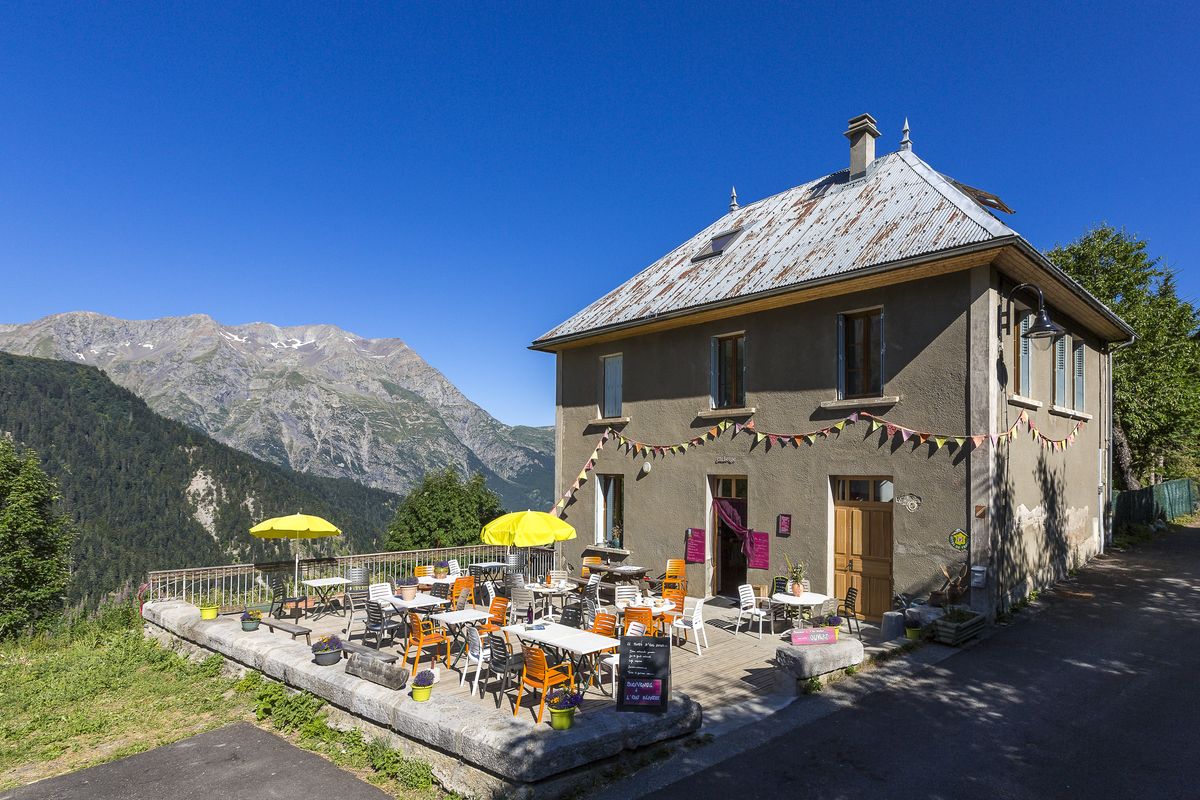
4. From Col d'Ornon to Villard-Reymond
Reaching the Col de Corbières, then Villard Reymond, means experiencing the legendary summits of the foothills of the north-west of the Massif des Ecrins (Petit Renaud, Grand Renaud, Rochail), enjoying an exceptional panorama over Oisans, Belledonne, the Massif du Taillefer and visiting the little mountain village of Villard Reymond.
Description
- At the foot of the button lift, follow the small road leading to the upper resort on the right.
- After 300 m, turn into the path leading to the right and Villard Reymond. The path crosses the ski slope, and then you turn right onto the signposted path zigzagging its way up the slope. At 1,650 m, leave the slope and go under the button lift on the left: the path you want enters the forest. At 1,690 m, you see the first of a series of travertine formations. At 1,820 m, the path leaves the forest and loops its way up to the mountain pastures. It reaches a small mountain stream, which you follow up to the Col de Corbières at 1,926 m.
- Descend the Villard Reymond slope along a path that is steep and rocky in places. The path goes through the forest at 1,730 m and reaches a wide track leading to the road at the foot of the village.
- Departure : Col d'Ornon
- Arrival : Villard-Reymond
- Towns crossed : Chantelouve, Ornon, and Villard-Reymond
9 points of interest
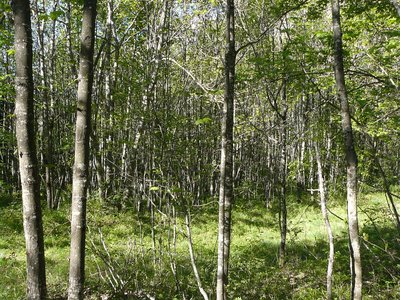
Aulnaie blanche du col d'Ornon - Site Natura 2000 - © Parc national des Ecrins - Justine Coulombier  Flora
FloraWhite alder forest
The forest is mainly made up of white alder trees. Their name comes from the fact that the underside of their leaves is covered with a whitish and silvery down. The alder forests grow alongside mountain streams, and to develop need land that is regularly subject to flooding. Due to damming and the removal of materials from the river beds, the white alder is now rare in Europe. The white alder forest in the Col d'Ornon is listed as a site of national interest and is part of the Nature 2000 network. It is the biggest in France, covering some 250 hectares. It can be seen along the Malsanne, the Merdaret and the Lignarre.
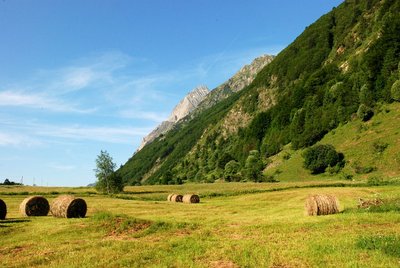
Prairies de fauche du Col d'Ornon, Natura 2000 - © Parc national des Ecrins - Bernard Nicollet  Flora
FloraThe Col d’Ornon hay meadows
Agricultural specialists consider that a meadow is natural when it has neither been manured nor ploughed for ten years. These meadows are very rich in flower species, and consequently they are the home of a whole host of pollinating insects, including bees, of course.
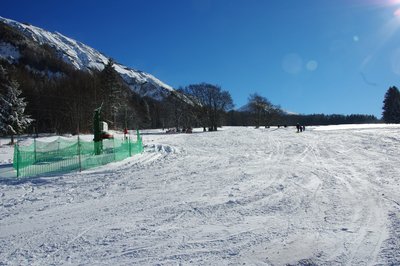
Station de ski du col d'Ornon - © Parc national des Ecrins - Emmanuelle Boithiot  Vernacular heritage
Vernacular heritageThe Col d’Ornon ski resort
The small ski resort of Col d'Ornon has two separate districts.
First, the Plan du Col (lower down) with its magnificent green slope. Here the resort’s first button lift was opened in 1965, in the early days of popular skiing holidays!
The Bois Barbet button lift (above), was opened in 1973. With a 450 m descent and an average slope at 36%, this button lift is a real technical feat. Although it no longer really meets the requirements of modern-day comfort, it continues its life as a tricky button lift running to the exceptional red and black slopes.
In winter, the resort hires four extra employees and works with a network of volunteers, who mobilise in support of the resort, making it a real centre of activity for locals and tourists.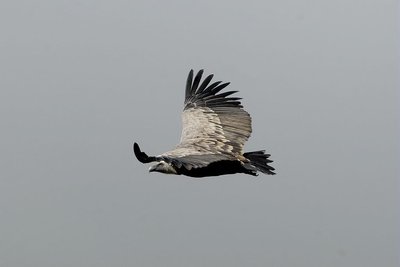
Vautour fauve - Coulon Mireille - PNE  Fauna
FaunaGriffon vulture
In summer, the griffon vultures leave their nesting areas, attracted by the many sheep grazing in the Alpine pastures. They soar up above the mountain crests. Expert scavengers, they have a fundamental role in the food chain, quickly eliminating corpses and so limiting the risk of disease spreading. This task as nature's undertakers has long made them an object of horror and fear for mankind. They are in decline in the Alps, but once again present in the Massif des Ecrins, following programmes to reintroduce them since 1980 in Les Causses and more recently in the Prealps.
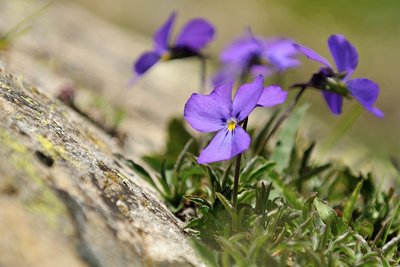
Pensée des Alpes - Mireille Coulon - PNE  Flora
FloraPansies
In a carpet of violet flowers, but sometimes yellow, white or multi-coloured, the Alpine pansy brings colour to the grass. It is also known as the mountain violet. Its spur, which can be seen on the back of the flower, is long, and only insects with long sucking pumps, such as butterflies, can gather pollen from them. Violets and pansies are members of the same family. To tell them apart, you need to look at the two side petals: they are turned downwards in violets, and upwards in pansies. Pansies are optimistic violets!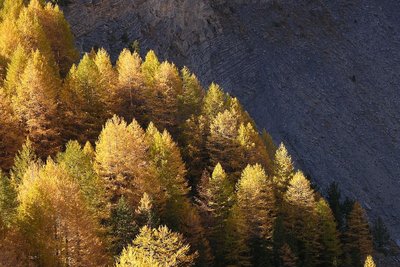
Mélèzin d'automne - Thierry Maillet - PNE  Flora
FloraEuropean larch
With a rich range of colours varying with the seasons, the fine and soft needles of the larch turn from light green in spring to emerald green in summer and gold in autumn. In winter, they fall, and the majestic larch seems to be dried out. Only the small round cones persist, which birds take to pieces to peck at the seeds. The flowers blooms at the same time as the first supple needles in spring: the female flowers have small raspberry-coloured cones and the male flowers are pale yellow catkins.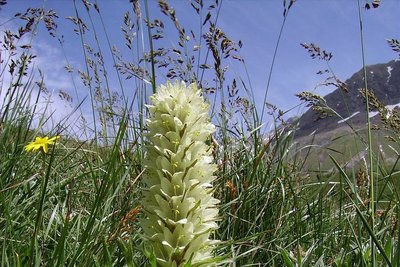
Campanule thyrsoide dans une pelouse à grande fétuque - Bernard Nicolet - PNE  Flora
FloraYellow bellflower
This campanula is easy to recognise, with its tufts of highly compact yellow flowers. It is one of the few Alpine biannual plants. The seeds scattered in autumn produce large, slender leaves the first year, growing in a rosette shape. The flower only blooms the second year, when it ensures its posterity, then dies. The plant can be found on Alpine grassland (from altitudes of 1,000 to 2,600 m) and on rocky ground and soil that is rich in limestone. Standing on a thick, hollow stalk with a great many leaves, it is 10 to 40 cm tall.
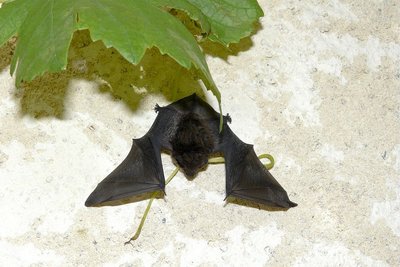
Pipistrelle commune - Jean-Pierre Nicolet - PNE  Fauna
FaunaCommon pipistrelle
Brown in colour with relatively short ears, the common pipistrelle and the kuhl's pipistrelle are rivals for the title of Europe's smallest bat. The common pipistrelle can be found in a wide range of ecological environments, even above an altitude of 2,000 m. In late 19th century France, school books celebrated the virtues of the bat. They are insectivores, eating a quarter or a third of their weight each day in mosquitoes and other insects. They emit ultrasounds that cannot be heard by the human ear. This technique helps them to find their way in the dark and capture their prey. They are often to be seen around lampposts, hunting insects that are attracted to the light.
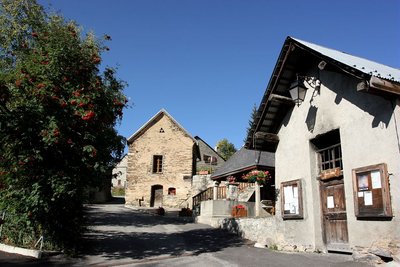
Villard-Reymond, le village - © Parc national des Ecrins - Pascal Saulay  Architecture
ArchitectureVillard-Reymond
Perched at an altitude à 1640 m, this is the highest village in Isère, and the second highest in France. 40 people live here today (but just six permanent residents), while there were almost 300 inhabitants 150 years ago. The fairly gentle slopes and favourable orientation gave rise to pastoral farming, despite the high altitude. The farmers used to work at the Ornon slate works, the women worked at home for glove-makers in Grenoble. Access to the valleys has always been difficult, and in 1960 a cable car was used to take cattle down into the Bourg d’Oisans plain. Today, people live in and visit Villard-Reymond for the quality of its environment.
Altimetric profile
Information desks
Maison du Parc du Valbonnais
Place du Docteur Eyraud, 38740 Entraigues
Reception, information, temporary exhibition room, reading room and video-projection on demand. Shop: products and works of the Park. Free admission. All animations of the Park are free unless otherwise stated.
Source

Report a problem or an error
If you have found an error on this page or if you have noticed any problems during your hike, please report them to us here:

